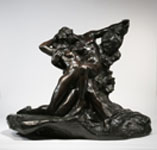| Biography | Inventory
Catalogue | Artists Represented | Auguste Rodin
One of the greatest and most prolific sculptors of the 19th century, Auguste Rodin {roh-dan'}, b. Nov. 12, 1840, d. Nov. 17, 1917, succeeded, often contentiously, in bringing new life and direction to a dying art. Rodin portrait Today major collections of his work on permanent display are at the Musée Rodin (Hotel Biron, Paris), the Rodin Museum (Philadelphia), and the California Palace of the Legion of Honor (San Francisco).
In 1875-76, after an exhilarating trip to Italy and firsthand knowledge of the sculptures of Michelangelo, Rodin completed his first masterwork, The Vanquished, a young male nude later called The Age of Bronze. This sculpture led to the first of numerous public controversies that were to beset Rodin throughout his career. Accustomed to the highly artificial appearance of most 19th-century academic sculpture, the critics of the day refused to believe that Rodin was able to model a figure so realistically without using plaster casts of a live model. In 1880 he received a commission from the French government to design monumental doors for a proposed new museum, a work that preoccupied him for the rest of his life. His starting point was Dante's Inferno, but the many figures he created in plaster for his Gates of Hell -- including models for The Thinker (1880) and The Kiss (1886) -- came to represent the sculptor's own vision of humanity's anguished progress.
During the 1880s, Rodin became one of the most successful French artists. He received many commissions for public monuments, including The Burghers of Calais (1884-95), the Monument to Victor Hugo (1889-1909), and the Monument to Balzac (1891-98). le PenseurAlthough Rodin regarded this last work -- a dramatic portrayal of Balzac's spirit -- to be one of his greatest, the society that commissioned it rejected the piece as an unfinished and grotesque botch. This led to one of the most bitter public debates in the history of 19th-century art.
Rodin was not only a sculptor of public monuments but a tireless artist who produced numerous small and intimate sculptures. These works range from highly developed pieces such as Eternal Spring (1884) and The Kiss, two of his most popular studies of youthful passion, to fragmentary studies of limbs and heads. He was also much in demand as a portrait sculptor and produced memorable images of many of the most famous men and women of his time, ranging from Victor Hugo (1883) to George Bernard Shaw (1906) and Pope Benedict XV (1915), and of many society figures on both sides of the Atlantic.
After 1900, Rodin worked mostly on a smaller scale, for example, on studies of ballet dancers (c.1910-12) and on drawings. The outbreak of World War I in 1914 brought him considerable hardship; his health and mental stability gave way rapidly before his death in 1917.
John L. Tancock
Source: The Grolier Multimedia Encyclopedia, Release #9.01, ©1997
Bibliography: Ruth Bulter, Rodin: The Shape of Genius (1993); Robert Descharmes and Jean François Chabrun, Auguste Rodin, trans. by E. Lausanne (1967); Albert E. Elsen, Rodin's Gates of Hell (1960; repr. 1985); Frederic V. Grunfeld, Rodin: A Biography (1987); William H. Hale, The World of Rodin (1969); Rainer Maria Rilke, Auguste Rodin, trans. by J. Lemont and H. Trausil (1945; repr. 1974); Denys Sutton, Triumphant Satyr (1966); John L. Tancock, The Sculpture of Auguste Rodin, rev. ed. (1976; repr. 1989).
Images: "Rodin: photo of the artist" (The Bettmann Archive), "le Penseur (The Thinker)" (Musée Rodin, Paris/Bridgeman Art Library)
Copyrights Notice and Disclaimer: Images of artists' works displayed throughout this site have been obtained from numerous sources, including digital libraries at educational institutions, educational software, and Mark Harden's Artchive. Credit is attributed when known. Some works are considered to be in the public domain, based on current U.S. and international copyright acts. For more information on copyright laws, please refer to the Artists Rights Society and Benedict O'Mahoney's The Copyright Web Site. [See also: DiscoverFrance.net Copyrights.]
Rodin Quotations:
"Nothing is a waste of time if you use the experience wisely." (1)
For further
information, please contact:
Canada: tel: (1) 604.688.2633,
fax: (1) 604.688.2685
